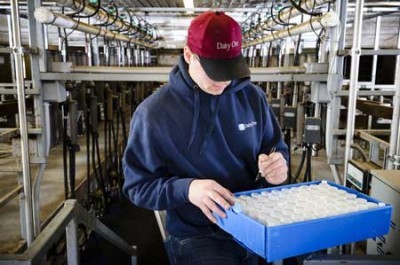posted by Spencer Parkinson on Tuesday, September 13, 2016
I have had the pleasure of being involved in agriculture since my youngest days in Idaho. My dad and his family had a small grains dry farm in southeastern Idaho where they also raised sheep…and kids. My dad also began building dams and terraces to mitigate soil erosion in the early to mid-1980s. Upon moving to Utah when I was nearly 8, I had my first job bagging feed for a local feed mill. Then, on to a family friend’s dairy where I’d work for about twelve of the next fourteen years of my life.
All the while, I was either experiencing agriculture (when I was along for the ride “helping”) or when I actually worked in agriculture (and experienced as well, of course), there was constant learning and adaptation going on whether or not I was aware of it. For example, my dad used data to help him understand where to build small dams and terraces to slow the movement of water. No, not with a GPS receiver hooked to his tractor and scraper like they do now (this would eventually come), but with physical maps along with personal experience and being “on site”.
When I worked at the feed mill in northern Utah, data collection continued. In my mind at the time the data collection I was doing was along the lines of, “I’ve been at work for three hours after school today – that means I now have about $10 to spend on whatever I want. I wonder what camping equipment I should buy at Smithfield Implement…”. That or “I’ve been lifting these 50 lb bags of dirt…I mean minerals for livestock… for three hours, I wonder how big my muscles are getting?”
As much as I thought data collection was measured by how much money I was making or whether I was in better shape for having worked, the real data collection happened with my dad and coworkers at that feed mill. The real data collection went something like this: “In order to deliver to our customer by this date, we need to order these ingredients to make this batch of feed by this time.” Or this, “Our normal ingredient is out – what can we order as a suitable substitute and still give our livestock customer what they need to keep their animals healthy?”
Jumping ahead a few years to when I worked on that dairy in northern Utah, data collection began to take on a whole new meaning to me. Yes, I still counted up my hours and figured out how much “bacon (or was it milk?) I’d be taking home in my next check”, but data collection became a whole lot more apparent. What I mean is that the milk tester, Norene, from the Dairy Herd Improvement Association (DHIA) would show up with her truck full of equipment, set up a temporary work space and “get in our way”. It’s a good thing Norene was such a pleasant lady – her friendly personality more than compensated for milkers not sucking as hard because of the meters (milkers fell off easier) and the bulky equipment to work around.

So why would Jeff (my boss) allow a lady to randomly show up (I thought) to slow down progress? Simply put, to enable MORE progress. Dairy farmers certainly don’t have to have their milk tested by DHIA, but can be at a disadvantage to other dairy farmers for not doing so.
You see, DHIA has been around for a long time (roots trace back to the Cow Testing Association (CTA) that started in America in the fall of 1905). Back then, production records were much more rudimentary – they weren’t easily searchable, uploadable, shareable, or really all that conducive to in-depth analysis. But, they still could tell a story. The interesting thing about DHIA and the dairy industry is they have long been engaged in “Big Data” before it was called that. Keep in mind we’re speaking on a relative basis; in other words, the volume of dairy data created and collected in 1905 was a tiny fraction of what is collected and analyzed today, not just in the dairy industry, but in all parts of agriculture and beyond.
Data collection in agriculture has long been a mindset that allows for continuous improvement. With so much data being created on a continuous basis, the thoughts of analyzing that data can be daunting. Thankfully, though, the sophistication of data analytics has kept pace with the rate of increasing data creation and management. Enormous strides in computing and software capacities have taken place at an increasing rate that make it much simpler to take vast amounts of dairy data (and other livestock, poultry, and crop production data for that matter) and convert it into actionable, practical steps to take to increase efficiency, sustainability and profitability.
So, beginning with my days “helping” dad, bagging feed and tripping over milk testing equipment to my analytics work today, I have a great appreciation for how much can be learned and applied from what may be viewed as a bunch of numbers in my head, on paper, or in a spreadsheet or database. After all, while having data is the key to setting yourself up for success, the appropriate understanding and application of that data will help you achieve success.